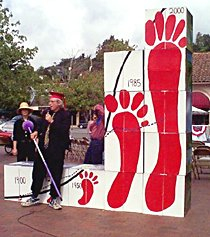
The ways we impact natural and cultural conditions:

Disturbance, an area is capable of recovery with time: based on the number of keystone species remaining.
Damage, the time for recovery is longer than the life of any of the longest lived keystone species.
Destruction, the area must be restored through adaptive management and active intervention.
| degrees | terms | actions | examples |
|---|---|---|---|
| low | Disturbance | repair | sanitary sewer discharge into a river |
| medium | Damage, | replacement | fish ladders on dams, oil spill in marshes, re-seed oyster reefs |
| high | Destruction | restoration | dam removal, replanting more diverse forests, or artificial wetlands. |
Dialectic: Two opposing views to account for the way something is described, analyzed, or examined based on its amount, behavior, character, or qualities.
• Preservation: to retain existing features, functions, and resilience in an intrinsically historical sense.
• Conservation: to keep from loss, harm or decay in a commercially viable sense.
How these related policies diverge.
Population Encyclopedia of Earth.